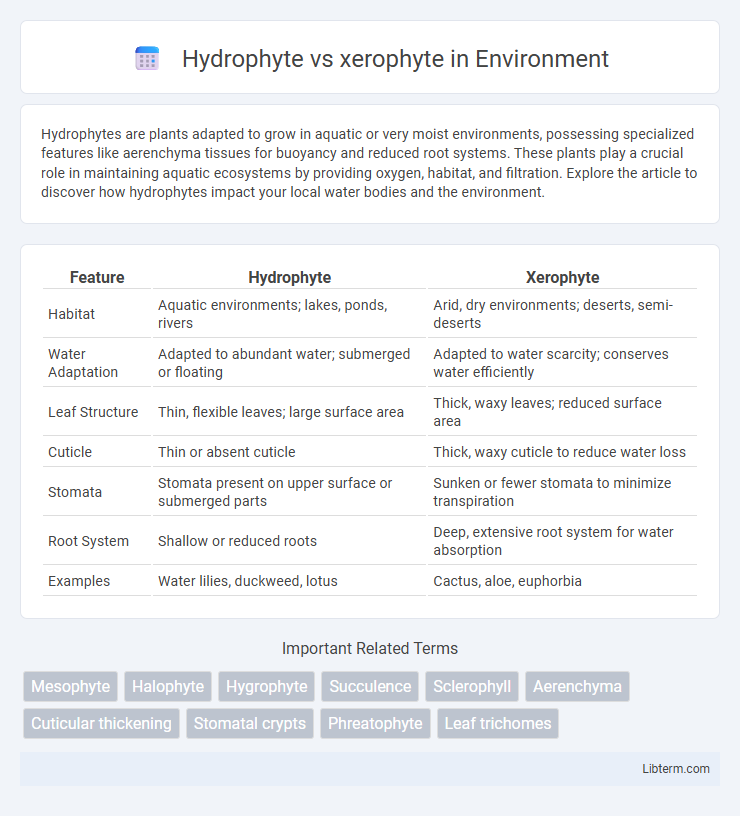Hydrophytes are plants adapted to grow in aquatic or very moist environments, possessing specialized features like aerenchyma tissues for buoyancy and reduced root systems. These plants play a crucial role in maintaining aquatic ecosystems by providing oxygen, habitat, and filtration. Explore the article to discover how hydrophytes impact your local water bodies and the environment.
Table of Comparison
| Feature | Hydrophyte | Xerophyte |
|---|---|---|
| Habitat | Aquatic environments; lakes, ponds, rivers | Arid, dry environments; deserts, semi-deserts |
| Water Adaptation | Adapted to abundant water; submerged or floating | Adapted to water scarcity; conserves water efficiently |
| Leaf Structure | Thin, flexible leaves; large surface area | Thick, waxy leaves; reduced surface area |
| Cuticle | Thin or absent cuticle | Thick, waxy cuticle to reduce water loss |
| Stomata | Stomata present on upper surface or submerged parts | Sunken or fewer stomata to minimize transpiration |
| Root System | Shallow or reduced roots | Deep, extensive root system for water absorption |
| Examples | Water lilies, duckweed, lotus | Cactus, aloe, euphorbia |
Introduction to Hydrophytes and Xerophytes
Hydrophytes are plants adapted to thrive in aquatic environments with abundant water availability, characterized by features such as thin cuticles and specialized air spaces for buoyancy. Xerophytes are plants evolved to survive in arid conditions with limited water, exhibiting adaptations like thick cuticles, reduced leaf surface area, and deep root systems for water conservation. Both categories demonstrate distinct physiological and structural modifications that enable survival in extreme moisture conditions.
Defining Hydrophytes: Adaptations to Aquatic Environments
Hydrophytes are plants specifically adapted to thrive in aquatic environments, exhibiting features such as aerenchyma tissue for efficient gas exchange and flexible stems that withstand water currents. Their root systems are often reduced or modified to absorb dissolved nutrients directly from water, while stomata may be present only on the upper surface of floating leaves to facilitate gas exchange. These physiological and structural adaptations distinguish hydrophytes from xerophytes, which are specialized to survive in arid, water-scarce conditions through mechanisms like thick cuticles and deep root systems.
Xerophytes Explained: Thriving in Arid Conditions
Xerophytes are plants specially adapted to survive in arid conditions by minimizing water loss and storing moisture efficiently. They exhibit features like thick cuticles, reduced leaf surface area, sunken stomata, and extensive root systems to extract water from dry soil. These adaptations enable xerophytes to thrive in environments with extreme drought and limited water availability.
Morphological Differences Between Hydrophytes and Xerophytes
Hydrophytes exhibit thin, broad leaves with large air spaces for buoyancy and efficient gas exchange in aquatic environments, while xerophytes possess thick, waxy cuticles and reduced leaf surface area, such as spines, to minimize water loss. Root systems in hydrophytes are often less developed due to water abundance, contrasting with the deep, extensive roots of xerophytes designed for water absorption from dry soils. Stomatal density in hydrophytes tends to be high and located on upper leaf surfaces, whereas xerophytes have fewer stomata often sunken in pits to reduce transpiration.
Physiological Adaptations in Hydrophytes versus Xerophytes
Hydrophytes exhibit physiological adaptations such as reduced cuticle thickness, large air spaces (aerenchyma) for buoyancy and gas exchange, and stomata located predominantly on the upper leaf surface to facilitate efficient oxygen diffusion in aquatic environments. Xerophytes possess thick, waxy cuticles to minimize water loss, sunken stomata or stomatal crypts to reduce transpiration, and specialized water storage tissues like succulence to survive prolonged drought conditions. The contrasting water availability drives these divergent adaptations, with hydrophytes optimized for excess water tolerance and xerophytes engineered for water conservation.
Water Absorption and Conservation Strategies
Hydrophytes exhibit specialized tissues like aerenchyma for efficient water absorption and storage, thriving in aquatic environments with abundant water availability. Xerophytes develop deep root systems and thick cuticles to minimize water loss, employing adaptations such as stomatal closure and trichomes to conserve water in arid habitats. These contrasting water absorption and conservation strategies reflect evolutionary adaptations to their respective water availability conditions.
Examples of Common Hydrophytes and Xerophytes
Common hydrophytes include water lilies, cattails, and lotus plants, all adapted to aquatic environments with features like aerenchyma for buoyancy. Xerophytes such as cacti, aloe vera, and sagebrush possess thick cuticles and deep root systems to conserve water in arid habitats. These adaptations enable hydrophytes to thrive in water-rich settings while xerophytes survive in drought-prone regions.
Environmental Roles and Importance
Hydrophytes play a crucial role in aquatic ecosystems by oxygenating water and providing habitat for diverse aquatic species, enhancing biodiversity and maintaining water quality. Xerophytes are vital in arid environments, preventing soil erosion, conserving moisture, and supporting unique wildlife adapted to extreme drought conditions. Both plant types contribute significantly to ecological balance by adapting to and stabilizing their respective environments.
Hydrophyte vs Xerophyte: Ecological Implications
Hydrophytes and xerophytes exhibit distinct adaptations that reflect their ecological roles in aquatic and arid environments, respectively. Hydrophytes possess specialized structures such as aerenchyma and floating leaves to maximize oxygen transport and buoyancy in waterlogged habitats, influencing nutrient cycling and aquatic ecosystem stability. Xerophytes display traits like thick cuticles, reduced leaf surface area, and deep root systems to conserve water, thereby shaping soil properties and community dynamics in desert and drought-prone ecosystems.
Conclusion: Key Differences and Applications
Hydrophytes thrive in aquatic environments with abundant water, exhibiting adaptations like aerenchyma for buoyancy, while xerophytes survive in arid conditions through features such as thick cuticles and deep root systems to minimize water loss. These contrasting adaptations highlight their ecological roles: hydrophytes contribute to aquatic ecosystem stability and water filtration, whereas xerophytes play critical roles in desert landscaping and soil erosion prevention. Understanding these key differences informs agricultural practices, habitat restoration, and climate-resilient plant selection.
Hydrophyte Infographic

 libterm.com
libterm.com